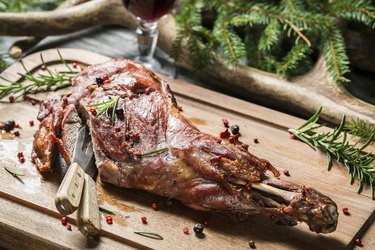
Venison meat, which comes from antlered animals like deer, elk and caribou, is lower in calories and higher in protein when compared to popular cooked meats like beef. Making venison roast in the oven results in a flavorful, tender and healthy meat dish.
Deer Roast Nutrition
Video of the Day
The recommended daily intake of cooked meats for adults, as per the American Heart Association (AHA), should be a little more than one serving per day, or at least nine servings per week. Ideally, lean or extra-lean cuts of meat, such as venison, are preferred when meeting the recommended 3-ounce serving size intake of cooked meats.
Video of the Day
Read more: 15 of the Best Lean Animal Proteins
A 3-ounce serving of cooked deer roast offers approximately 162 calories, 30.6 grams of protein and 3.33 grams of fat. Compared to a similar serving of roasted beef tenderloin, which has 269 calories and 20.1 grams of fat, venison roast is lower in calories and notably lower in saturated fat.
Consuming a diet rich in saturated fats can lead to a build-up of LDL, or 'bad' cholesterol, over time. A single serving of beef contains 7.97 grams of saturated fats, while a serving of venison has only 1.89 grams of saturated fats. So, if you're looking to lower your saturated fat intake and prevent the incidence of cardiovascular disease, switching to venison rump roast might be the answer.
Read more: How to Cook Venison Steaks in a Crock Pot
Venison rump roasts are also a good source of certain minerals. A 3 ounce serving offers 23.8 milligrams of magnesium, 221 milligrams of phosphorus, 264 milligrams of potassium and 228 milligrams of sodium. These major minerals help balance the body's pH levels, are required for muscle contraction and support the nervous and immune systems.
Read more: How to Cook Elk Backstrap
Venison is an excellent source of choline, a water-soluble compound that's essential for several body processes. A single serving of venison offers 113 milligrams of choline. Without choline, the body's nervous system and cellular communication methods would not function. According to a December 2014 study published in The Journal of Nutrition, a diet rich in choline may also be responsible for lowering the risk of liver disease.
Venison Roast Oven Ingredients
- Venison Rump Roast: Use a leaner cut of venison with little to no fat. To remove the meat's gamey flavor, the USDA recommends soaking the deer meat overnight in a solution of 1 quart of cold water with 1 cup of vinegar. Cover the deer roast completely, refrigerate and discard the marinating solution before cooking.
- Spices: Seasoning with salt and pepper can also help remove the gamey flavor of the meat. Additional spices that go well with venison roast in the oven include thyme, sage, marjoram and rosemary.
- Fat: Rubbing the venison with butter or oil will help keep it from drying out in the oven when roasting. Bacon-wrapped venison roast is another alternative for a rich and moist venison roast.
- Venison Roast Marinade: A venison roast marinade is helpful to tenderize the meat even further, and to keep it moist while roasting. A common venison roast marinade could be tomato sauce, lemon juice and even store-bought steak sauces.
- Vegetables: Onions, carrots and potatoes make an excellent addition to the deer roast.
Tip
The University of Minnesota Extension explains that trimming fat and connective tissue off-cuts of venison will significantly reduce the meat’s gamey flavor. Trim before cooking, and ideally as soon as you can.
How to Make Deer Roast
- Preheat the oven: The USDA recommends that venison be cooked to 325 degrees Fahrenheit. According to Michigan State University Extension, the tenderloins, loin steaks and round cuts of deer roast are the best cuts for roasting in the oven.
- Season the meat: Rub the deer roast with salt, pepper and your choice of herbs, along with some oil. As venison is a low-fat meat, it can dry out quickly. Adding fat like olive oil and butter, or even covering it with bacon, can help retain moisture while the meat cooks. Marinating the roast before cooking will also help keep the meat moist.
- Add cubed vegetables: Add in cubed potatoes, carrots and onions to the pan.
- Roast the venison: A pound of deer meat roasts at 325 F for 20 to 25 minutes. Use a meat thermometer to ensure that the roast reaches an internal temperature of at least 160 F.
- University of Minnesota Extension: “Cooking Venison for Flavor and Safety"
- AHA: "Suggested Servings from Each Food Group”
- The Journal of Nutrition: "Higher Dietary Choline Intake Is Associated with Lower Risk of Nonalcoholic Fatty Liver in Normal-Weight Chinese Women1,2”
- USDA FoodData Central: “Venison/Deer, Roasted"
- USDA FoodData Central: "Beef, Tenderloin, Roast, Separable Lean and Fat, Trimmed to 1/8" Fat, Select, Cooked, Roasted"
- MSU Extension: “How to Cook Venison"
- USDA: "Roasting Those 'Other' Holiday Meats"
- FoodSafety.gov: "4 Steps to Food Safety"